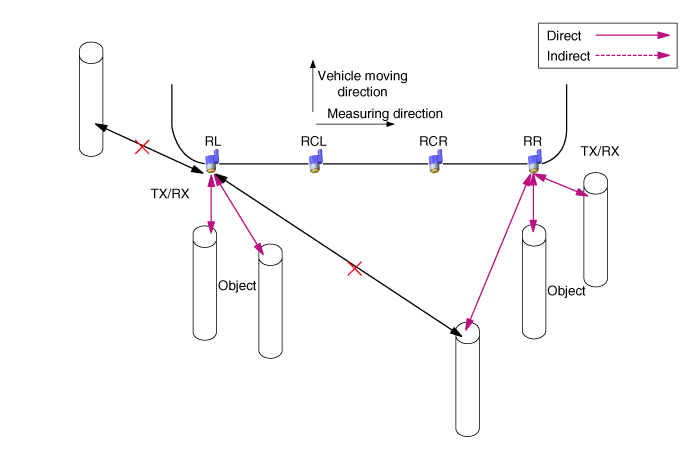Kia Niro: Front / Rear Parking Assist System / Description and operation
| System Configuration |
PAS consists of 8 sensors (4 in the front and 4 in the rear) that are used to detect obstacles and transmit the result in three separate warning levels, the first, second and third to IPM (BCM) via LIN communication. IPM (BCM) decides the alarm level by the transmitted communication message from the slave sensors, then operates the buzzer or transmits the data for display.
Block Diagram

System Operation Specification
| 1. |
Initial mode - Front sensor
|
| 2. |
Initial mode - Rear sensor
|
| 3. |
Normal mode - Front sensor
|
| 4. |
Normal mode - Rear sensor
|
Sensing Area
| 1. |
Measurement condition – PVC pole (diameter 75 mm, length 3 m), normal temperature |
| 2. |
Distance range detected objects (Measured directly in front of sensor)
|
Horizontal Sensing Area

Vertical Sensing Area

Distance Measurement
| Direct Measurement |
Transmission and Reception are executed with one sensor
(FL, FCL, FCR, FR, RL, RCL, RCR, RR each sensor execution)

| Indirect Measurement |
(FCL > FL, FCL > FCR, FCR > FCL, FCR > FR, RCL > RL, RCL > RCR, RCR > RCL, RCR > RR Execution in order)
With two or three sensors, one of them sends the transmission and the others get the reception.

| Direct and Indirect Measurement at once |
With two or three sensors, the one sensor performs both transmission and reception, and the others perform only reception.

RPAS alarm system
When the RPAS sensor detects the object, warning is operated by audible alarm device as like buzzer. RPAS sensor sends data to BCM with LIN communication and BCM implements audible warning for each RPAS SENSOR by priority. And it performs a role of gateway only when it sends visible alarm device such as Cluster.
| – |
Sensor buzzer/display information processing method of BCM In case of RL/RR sensor information, the BCM handles each sensor information directly about Display and buzzer output function. Buzzer output of CL/CR sensor, BCM handles center combination information by priority both sensor, Otherwise, about fail display information,BCM send that to cluster each sensor information. |
System operation Spec - Front sensor
When the system has the power (after IGN ON and D gear), MICOM checks every sensor channel. In case it is not find any error, it sounds 500ms afterward. But it finds any error even a sensor, it sounds buzzer corresponding fault sensor instead of initial starting alarm. If PAS ON switch in OFF, system doesn't work. Function for normal mode entrance is as below.

* In the initial mode, IPM (BCM) judges only sensor fail.
With D gear, system function is as below.

With D gear releasing, system function is as below

System Operation Spec - Rear sensor
When the system has the power (after IGN ON and R gear), MICOM checks every sensor channel.In case it is not find any error, it sounds 300ms buzzer 500ms afterward.But it finds any error even a sensor, it sounds buzzer corresponding fault sensor instead of initial starting alarm. Function for normal mode entrance is as below

With R Gear, system function is as below

With R gear releasing, system function is as below

?acceptable error range on waveform ±10%
Alarm Output Specification classified by distance between sensors
Condition logic according to priority of alarm level is as below. (the identical sensor)

*? value definition
| 1. |
low priority sensor off : ? = 0ms |
| 2. |
low priority sensor is 1st warning level : ? < 340ms |
| 3. |
low priority sensor is 2nd warning level : ? < 170ms |
*? value definition
| 1. |
low priority sensor is 1st warning level : ? = 1700ms |
| 2. |
low priority sensor is 2nd warning level : ? = 1700ms |
| 3. |
low priority sensor is 3rd warning level : ? = 700ms |
Alarm control by sensing distance is as below
| 1. |
First warning area (Front: 61 cm (24 in) - 100 cm (39.4 in), Rear: 61 cm (24 in) - 120 cm (47.2 in) )
|
| 2. |
Second warning area (Front/Rear: 31 cm (12.2 in) - 60 cm (23.6 in))
|
| 3. |
Third warning area (Front/Rear: less than 30 cm (12.2 in))
|
Visible Alarm Indicator Specification
| 1. |
Alarm level per distance - Front, Rear sensor When the gear is applied to R, cluster lights the indicator as below figure.When the system finds an object, it lights indicator immediately. During sensing an object, if there is no object, it lights indicator that is no alarm status for two seconds and then turns out afterward detecting an object. (But when it turns third step alarm to No alarm status, it lights third step alarm for two second and turns out.)
* It only displays the position of detected obstacle. * Indicator flickers every 1 second at third step alarm. * Integrated display (FCL/FCR, RCL/RCR). |
 Components and components location
Components and components location
Component Location
1. Body Control Module (BCM)
2. Ultrasonic sensor
Front/ ...
 Parking Assist Sensor Components and components location
Parking Assist Sensor Components and components location
Component
...
Other information:
Kia Niro 2017 (DE HEV) Service Manual: Description and operation
Description
System Overview
The System offers the following features:
–
Changing the state of engine ignition and power by using the start button.
–
Controlling external relays for ACC / IGN1 / IGN2 terminal switching
and STARTER, w ...
Kia Niro (DE HEV) Owners Manual: Releasing the parking brake
To release the parking brake, depress the parking brake pedal a second time while
applying the foot brake. The pedal will automatically extend to the fully released
position.
WARNING
Whenever leaving the vehicle or parking, always come to a complete stop
and continue to depress the bra ...




